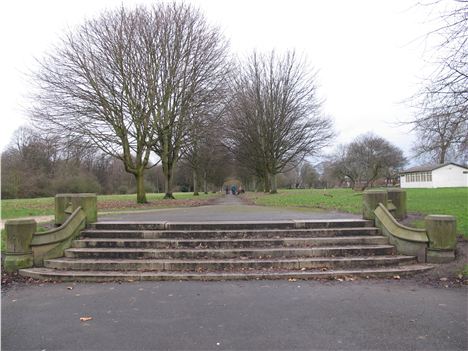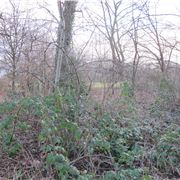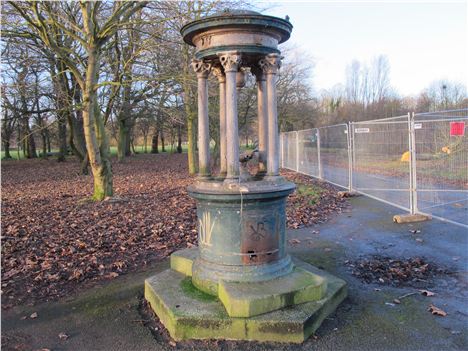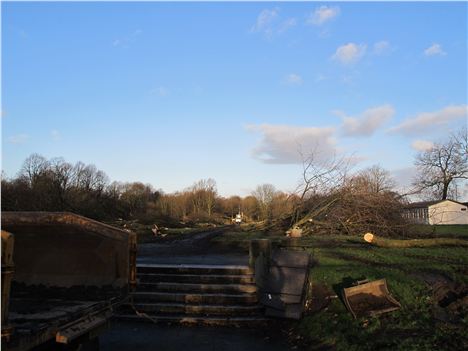EDDIE FLANAGAN is clear.
And he needs to be. He's started to chop down trees in Alexandra Park and some people aren't happy about the two to three week process of tree culling.
The senior officer in charge of the Alexandra Park project says, "There's a small group of locals who disagree with us over strategy but the council is committed to delivering a restored park.
"We've got £5.5m of improvements taking place. As part of this we're creating 7,000 square metres of new planting, including 100 new trees. We will be taking around 250 trees down from around 1,600 trees. So we're losing around 10% but we're delivering a much better park and a much better amenity."
The project isn’t about restoring the park to exactly the way it was when it was first opened, it’s about ensuring it can be used and enjoyed by as many people as possible.
The money comes from a split of £2.2m from the Heritage Lottery Fund (HLF), £2.8m from the city council, and £545,000 from the Lawn Tennis Association and the England and Wales Cricket Board.
The 'small group' Flanagan is referring to is Save Alexandra Park's Trees (SAPT). He seems bemused by some of the attitudes of the protestors. One individual apparently told him they'd rather see no improvements to the park if one tree had to fall.
 Cherry trees on a terrace that was surprised to have them
Cherry trees on a terrace that was surprised to have them
That level of tree-fanaticism, is categorically not the majority view of the protesters. They say they want the park to improve as well, but not this way.
Rionne Brennan, of SAPT, says, "In every communication with the council and councillors the majority of the residents objecting to the extent of fellings have been keen to express support for the development of Alexandra Park. Residents have simply requested that the specific plans for felling should be revisited with a view to seeing if a more sensitive approach can be identified to maximise the protection of this natural asset.
"Residents responded as soon as the exact extent of fellings became more widely communicated in late November 2012. Many Residents attended the Open Day in Alexandra Park on 1 December at which the detailed felling plans were displayed (click here).
"Concerns were raised at this Open Day. Residents would have preferred to respond to this aspect of the plan during the development stage but unfortunately the exact extent of fellings had not been well publicised. Indeed on all the plans included in the park, and the plans contained on the official Alexandra Park website, the felling details had been omitted."
Both Eddie Flanagan and Councillor Rosa Battle, Manchester City Council executive member for culture and leisure, disagree about the council masking the felling.
“Throughout the consultation process we discussed the number of trees that were being taken out of the park, and through discussion with the community the original number of trees to be removed has been reduced," Cllr Battle says.
"We've been working on this, the designs and securing the funding, for ten years," says Eddie Flanagan. "We've involved local people right from the start. One of the problems is that there's been a lack of resource and maintenance, many areas of the park have become overgrown. There's been a lot of self-seeding for instance which would obviously have been removed if the park had had the resources.
 Dangerous neglect"The result is people have told us they don't feel safe in many areas of the park or they fear they might see something inappropriate happening."
Dangerous neglect"The result is people have told us they don't feel safe in many areas of the park or they fear they might see something inappropriate happening."
Clearing out unintended natural clutter seems eminently reasonable. The disgraceful neglect of public parks across the country, parks once renowned for their beauty, their colour, and the loving care lavished upon them (see yellow box below) led to a collapse of their reputations. The physical fabric of ornamental fountains and benches became degraded, self-seeded thickets grew in which people worried about lurking criminals and perverts.
Alexandra Park like so many others began to look and feel dangerous.
Alexandra Park back in the day, colourful and black and white
SAPT understand many of the the points being made by the council over the upgrading of the park, but it's clear they don't trust the local authority.
Ian Brewer of the group disputes the number of trees that will go and the rationale by which they are chosen.
"They’re not identifying ash dieback, horse chesnut blight or oak decline," he says. "We think if you did a proper survey of all the trees in this park 25-30% of them are due to die in the next 10 years due to natural fungal infection. This isn’t even being looked at or addressed.
"The Council say they are taking out 250, if you look at the plans properly it's more like 400. They want to plant around 90 trees, so if they take out 400 and maybe another 400 fall over due to fungal infection that’s going to be 800 trees gone and there’s only 1600 here to start with.
"We’re not against the renovation of the park," he continues. "We’re all in favour of seeing Chorlton Lodge (a lovely building close to the entrance of the park) done up, and the pavilion and a lot of the other improvements look really good.
"We’re not in favour of six tennis courts though, clearing the ground for that many courts means taking out about 30 mature ash trees. If they put four courts in they could do that without taking out any trees so I don’t know why they’re insisting on six.”
Ian Brewer then accuses the Council of deceiving the public over the Heritage Lottery Grant.
“Funding for the park has been partially received from HLF. They want to restore this area (the old terrace) to how it was in the 1920s and 30s. Manchester City Council say that HLF stipulate that they’re not going to put up funding unless this is done. That means no more trees, just ornamental planters.
“But I spoke to HLF and they said they hadn't said that about the terrace. So bullshit from the council to blame the HLF because felling is always going to be unpopular which is why the council have tried to hide it until the last moment from the public.”
The council says that's simply not true.
Eddie Flanagan again.
“None of that makes sense. We’ve not said the Heritage Lottery Fund have stipulated anything, we’ve worked with them and jointly developed the plans for the park. The project isn’t about restoring the park to exactly the way it was when it was first opened, it’s about ensuring it can be used and enjoyed by as many people as possible. We're certainly not blaming the HLF."
To outsiders it's curious how such an eminently worthwhile and seemingly uncontroversial aspect of city life such as spending millions on a neglected park can lead to conflict.
But maybe that's par for the course at present. Maybe there's something else at work. People have - if council election figures are anything to go by - become divorced from the straightforward democratic process of voting in representives and then going along with the decisions made by them. Have for example the protesters at Alexandra Park all voted in recent local council elections?
The way it should work of course is that any grievance is taken to the local councillor who then represents that view in the Town Hall. If the democratically elected council still proceeds having taken an objective decision then due process has been observed. Job done.
But it appears there's a growing issue with people over how the decisions are being made. There's a suspicion the civil service of the council, rather than the elected representatives are setting the agenda and making the decisions? The latter should lead the former not the reverse. Councillors shouldn't be the mouthpiece of the bureaucrats, selling their decisions to the public. They should be the voice of the people telling the bureaucrats what to do. Hence democracy, not bureaucracy.
If Confidential's experience of the Library Walk row (click here) is anything to go by, then these fears are being realised. The councillors on the planning committee at the meeting in which approval was given for blocking Library Walk had no competence in design and planning. Their questions to the planners (the civil service) were an embarrassment. They failed to represent the people so how could they accurately represent people's views to the planning authority?
Of course, things still have to get done, work has to be delivered, government has to govern.
Judgements have to be made.
So, Confidential is with the council over Alexandra Park. The park is a shambles at present with a reputation to match. What should always be remembered as well is that this was never intended to be a country park in the city, it was always intended to a formally designed, highly maintained park with recreation facilities included.
As Ben Robinson from Confidential went down there to gather some information and take pictures, all the three women on the editorial desk told him to be careful. They described the park as 'rapey'.
If Alexandra Park can recover even a little of its former glory then all the locals, and their visitors, will benefit. The careful cutting back in tree stock, much of it self-seeded or planted ad hoc as a stop gap measure in the years of decline, is thus a price worth paying.
Despite the two thousand people who have signed a petition about the trees Ian Brewer of SAPT admits there's only "an active core group of about 15."
He also says, "I’m going to be more than quite upset if the trees go, I’m going to have to find another park to go in because I’m not going to want to come here again because I’ll remember it how it was.”
In that case, as my gran used to say, he'd be cutting off his nose to spite his face. And that's stupid.
You can follow Jonathan Schofield here @JonathSchofield. You can follow Ben Robinson on @BenPRobinson
The Saddest Municipal Tale
THE FALL from grace of Britain's great urban parks (excluding the Royal Parks in London) was one of the biggest disasters of the dire, polarised, eighties.
Inefficient and narrow-minded councils blamed a heavy handed, occasionally vindictive, government. The result was a collective, and generally disgusting dereliction of duty, the responsibility for which was tossed between left and right factions. It was bad governance all round.
In the nineties public parks got worse.
The result was the poorest areas lost their most beautiful and useful amenity. The British park, that object of so much local pride a generation or two before, was in the gutter.
The timing was evil perfection. Just as inner-city communities lost so many jobs, they also lost one of their main civilising resources.
Families were hit the hardest of course, as playgrounds rusted, playing fields decayed and drainage failed.
Meanwhile park departments were ravaged and destroyed. Flower beds were torn up (Manchester's parks were once famous for the beauty of their floral displays). 'Wild' areas were encouraged and a big fat lie told about how these were better for biodiversity, and so much more natural. 'Cheaper', the officials meant.
Bad landscape designers went one step further and planted low maintenance, dark leaved, spiky things that hoarded litter like dragons jealous of their treasure. It was laughably bad.
And tragic of course. Especially for the good people, both in councils and in the community around, working hard to maintain parks as, at least, a respectable shadow of their former selves.
 Avenue - Alex ParkThe result, as stated above, is that municipal public parks, emptied of park keepers. They were left to moulder and worst of all they became a byword for trouble. They became, aside from the odd accidental survival such as the magnifient lime avenue at Alexandra Park (see picture in this panel), almost ugly.
Avenue - Alex ParkThe result, as stated above, is that municipal public parks, emptied of park keepers. They were left to moulder and worst of all they became a byword for trouble. They became, aside from the odd accidental survival such as the magnifient lime avenue at Alexandra Park (see picture in this panel), almost ugly.
The Victorians it seems, knew better than we did the need for urban populations to have beautifully kept parks on their doorstep.
One of the express aims of Manchester with its nineteenth century parks' policy (Alexandra Park was opened in 1870) was that parks were for everybody regardless of class, providing fresh air, recreation and natural beauty. A target for Alexandra Park was to keep families together in shared recreation.
Things have been slow to improve.
HLF funding, and targeted council monies have started to scratch the surface, or occasionally with 'star' parks make significant changes in park maintenance and management over the last decade. But the effect has been piecemeal, some excellent work has been done at Heaton Park for example, but it's scarcely parkwide, and excludes the Hall which lies closed to the public.
The work of Friends Groups has helped - some volunteers giving weeks of their personal time and effort to improve their parks. Platt Fields Park friends group is an exemplar.
Nothing has been done in Manchester to match Stanley Park's reinvention in Liverpool. In fact the city lags behind its Merseyside neighbour in the management of its green spaces.
Finally, even with the improvements recently, can we really say that at the highest level of local and national governance the value of well-maintained parks and their contribution to well-being has been understood?
Are the parks liable in the future to be again the first on the cutback list?
One last point.
Many of the parks in Greater Manchester, in Britain, were created from private patronage supporting local authorities.
Central and local government are both justified in 2013 in wondering when are the business leaders, entrepreneurs and private individuals with wealth going to again live up to their responsibilities when it comes to parks? (JS)
 I am a broken drinking fountain - honestly what happened to my park, what happened to me?
I am a broken drinking fountain - honestly what happened to my park, what happened to me?
 Down in the park a hundred years ago
Down in the park a hundred years ago
 Ugly fence surrounding the felling area in an untended part of the park
Ugly fence surrounding the felling area in an untended part of the park













